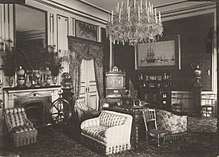Yellow Mansion, Copenhagen
The Yellow Palace (Danish: Det Gule Palæ), or Bergum's Mansion, is an 18th-century town mansion situated at Amaliegade 18, next to Amalienborg Palace, in the Frederiksstaden district of Copenhagen, Denmark. It is considered the first example of Neoclassical architecture in Copenhagen.
| The Yellow Palace | |
|---|---|
 | |

| |
| General information | |
| Architectural style | Neoclassical |
| Town or city | Copenhagen |
| Country | Denmark |
| Construction started | 1758 |
| Completed | 1764 |
| Client | H. F. Bargum |
| Design and construction | |
| Architect | Nicolas-Henri Jardin |
Originally built as a burgher's home, the mansion was acquired by the Danish Royal Family. Prince Christian of Glücksborg, later to become Christian IX of Denmark, took up residence there, and it became the birthplace of his children Frederick VIII of Denmark, Alexandra, Queen of the United Kingdom, George I of Greece and Maria Feodorovna, Empress of Russia.
Today the building is owned by the Danish Palaces and Properties Agency and houses the Lord Chamberlain's Office.
History
When Frederiksstaden was laid around 1748, it was envisioned as a uniform Rococo district. All new buildings had to comply with certain guidelines stipulated by Nicolai Eigtved, the district's masterplanner. After Eigtved's death in 1754 they were in principle upheld but as fashions changed they were somewhat relaxed. The Yellow Mansion was built from 1759 to 1764 for the merchant Frederik Bargum. The architect was Nicolas-Henri Jardin and he designed it in the Neoclassical style.
Carl Friedrich Busky (1743-1808), a wealthy merchant and prussian consul, acquired the mansion in 1775. He owned it until his death in 1808.
.jpg)

King Frederick VI purchased the mansion in 1810 to use it as a guest residence for relatives visiting the royal family. In 1837, King Frederik VII handed the property over to his nephew Prince Christian of Glücksborg who had just arrived in Copenhagen from Germany. At this stage no one knew that he was later to become Christian IX as the first Glücksburg king of Denmark. Prince Christian took up residence in the mansion and lived there until 1865 when he had become king and moved into Amalienborg Palace.
Later Prince Valdemar lived in the Yellow Palace until his death in 1939 as its last royal resident.[1]
Architecture
The building has been described as the first neoclassic building in Copenhagen.[2]
The site also includes Garderstalden (English: Guard's Stable), which was built in 1842 to designs by Jørgen Hansen Koch. It was used both for Christians af Glücksborgs 's horses and those of the horses of the Royal Guards who were on duty at the mansion. In 1923 the roof was converted into a Mansard roof with accommodation on the upper floor. The building was renovated and adapted by Bertelsen & Schewing in 2013. It contains administration in the ground floor and apartments on the upper floor.[3]
See also
References
- "The Yellow Palace - And the Glückborg Dynasty". Copenhagen Portal. Retrieved 2010-01-24.
- "Amaliegade 18, Det Gule Palæ". Slots og Ejendomsstyrlsen. Retrieved 2010-01-24.
- "Ny function til en ny tid" (in Danish). Bertelsen & Schewing. Retrieved 2013-06-21.